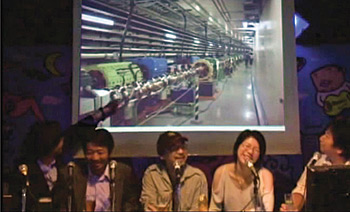
A night of wonder
Men and women wearing gaudy dresses, looking for customers under garish neon signs—this is a common sight in Kabuki-cho, Shinjuku, a famous entertainment and red-light district in Tokyo, Japan. Walking down an alley past bars and nightclubs, you will see a hand-written sign posted on a shabby building: “The Accelerator's Night 3.”
This sleepless town is home to the “Accelerator's Night,” a science seminar produced by Kenichi Kojima, who organizes group tours to such places as laboratories, factories, and historic places. His program is called “Shakai-ka Kengaku ni Ikou!” (Translation: Let's go on a field trip!). More than 7000 people have registered online, creating a unique field-trip club for adults only.
What's a science seminar doing in the red-light district? It started with a traffic jam.
For two years, Kojima has been organizing field trips to KEK, the international particle physics center in Tsukuba. On one of those excursions the bus got stuck in traffic. One of the tour guides, Satoru Yamashita of the International Center for Elementary Particle Physics at the University of Tokyo, killed time by talking about accelerator science, particle physics, and the International Linear Collider project for two full hours. “People on the bus enjoyed his talk very much, so I proposed that Dr. Yamashita have a seminar with his colleagues,” Kojima says. He arranged to hold the the first “Accelerator's Night” at a Kabuki-cho nightclub owned by a friend.
Yamashita says he was skeptical that the seminar would find an audience, but “surprisingly, the place was packed. They are not only interested in the science but also fascinated by the machine itself. That really opened my eyes.” Novelist Aya Kaida was one of the seminar moderators. “The accelerators are such beautiful machines. I don't think scientists are aware of that very much,” she says. “It is a shame to not show these beauties to more and more people.”
For one recent seminar the basement nightclub was crowded with about 70 attendees, some with physics backgrounds but most with no connection to the field. There were many women in the room—unusual for a physics talk in Japan. Three experts, including Yamashita, spoke about radiation physics, particle physics basics, and how an accelerator works. “People gathering here are very active in so many ways. It is very important for us to introduce our efforts to people like them,” says Junpei Fujimoto, a KEK scientist and seminar speaker. “A new project like the ILC especially needs more attention and understanding from the general public. Hope-fully, we can have seminars like this regularly in different cities.”
Yamashita thinks the seminars also give scientists valuable practice in talking with the public. “We are learning so much from the audiences, such as where their interests lie and how we should attempt to gain more understanding,” he says.
Following a brisk question-and-answer session, the seminar finally ended more than an hour late, and the scientists set off running toward Shinjuku station to catch the last train home.
Rika Takahashi, ILC Global Design Effort
Click here to download the pdf version of this article.






